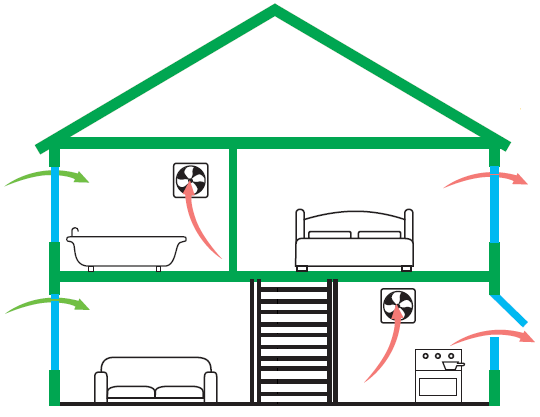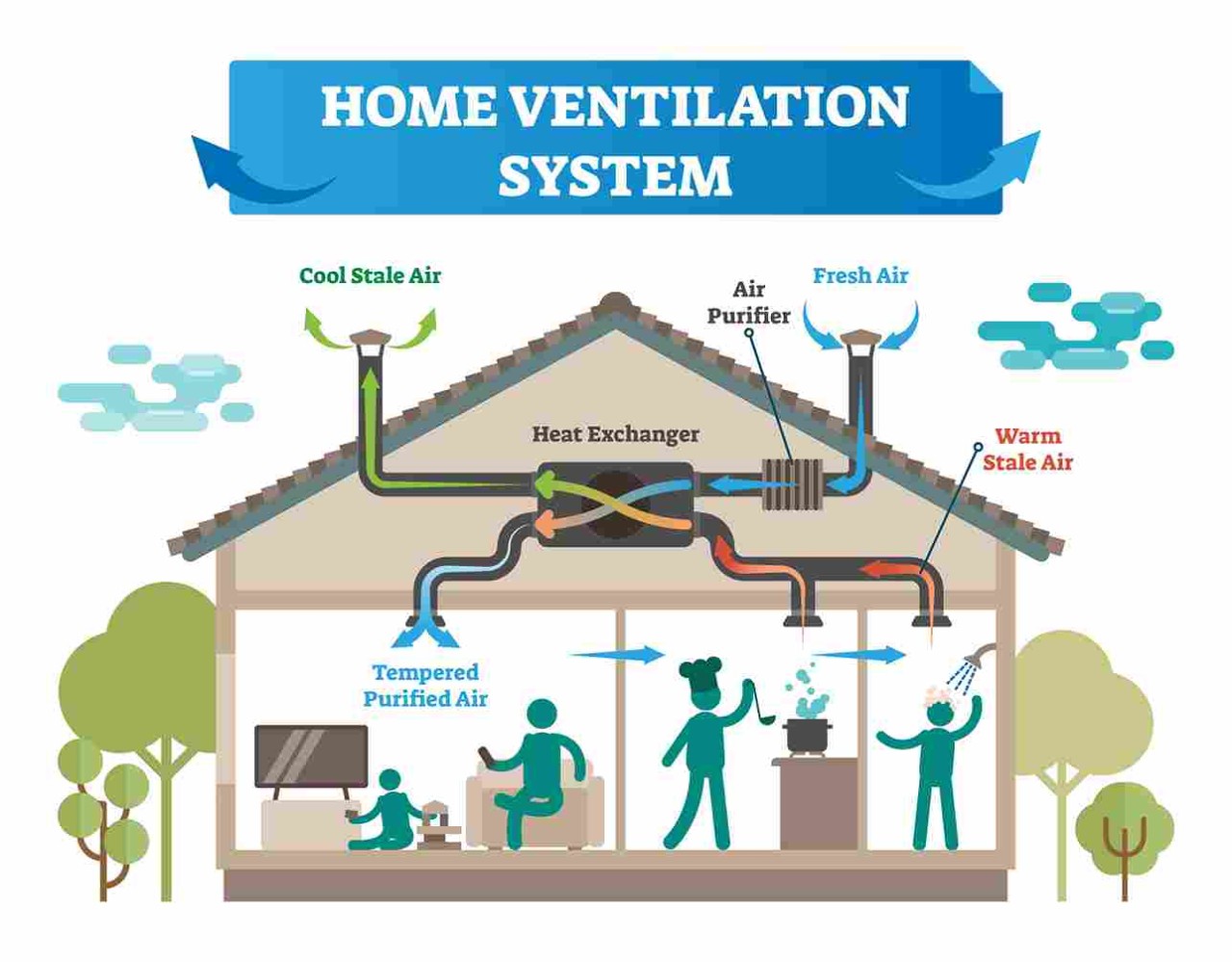Exploring Innovative Solutions for Optimum Home Ventilation Equipments
Home ventilation plays an important duty in keeping health and wellness and comfort within living rooms. With developments in modern technology, innovative options are arising to maximize these systems. Smart air flow, energy healing ventilators, and progressed purification are reshaping how air top quality is managed - Home Ventilation Melbourne. Nonetheless, the integration of these modern technologies elevates questions about their efficiency and versatility in diverse home environments. What effects do these developments hold for future living criteria?
The Significance of Home Ventilation for Wellness and Comfort
Although commonly forgotten, home ventilation plays a vital duty in preserving both wellness and convenience within residential spaces. Adequate air flow is crucial for the circulation of fresh air, which helps to thin down interior contaminants such as volatile natural compounds, allergens, and smells. Without appropriate airflow, these impurities can collect, resulting in respiratory concerns and other health troubles. On top of that, effective air flow adds to managing humidity levels, preventing mold and mildew growth and architectural damage. By making certain a balanced exchange of air, homeowners can take pleasure in a more positive indoor setting, improving total wellness. Adequate ventilation can enhance power performance by reducing the requirement for too much home heating or air conditioning, ultimately resulting in lower utility expenses and a much more lasting living room.
Smart Air Flow Equipments: Harnessing Technology for Efficiency
Smart ventilation systems represent a considerable innovation in home air monitoring, leveraging IoT assimilation for enhanced control. These systems not just advertise power performance but also offer remote monitoring capabilities, allowing users to optimize their indoor environments seamlessly. By utilizing technology, house owners can accomplish enhanced air high quality while decreasing energy consumption.
IoT Combination Benefits
How can IoT integration transform traditional ventilation systems right into very effective wise options? By integrating Web of Things (IoT) innovation, ventilation systems can achieve real-time surveillance and control, improving their functional performance. Sensing units put throughout a home collect information on air temperature level, high quality, and humidity, enabling for automated adjustments based upon present conditions. This prompt responsiveness causes enhanced interior air high quality and comfort levels. Furthermore, IoT-enabled systems can connect with various other clever home tools, developing a natural ecological community that enhances power usage. Customers can likewise accessibility and manage their air flow systems from another location by means of smartphones, offering convenience and raised control. On the whole, IoT assimilation stands for a considerable advancement, bringing intelligence and adaptability to traditional ventilation practices.
Energy Effectiveness Features
As power performance ends up being a vital focus in modern home style, progressed ventilation systems provide cutting-edge features that significantly lower energy usage. These clever ventilation systems use sensing units to keep track of interior air humidity, temperature, and top quality degrees, immediately readjusting airflow to preserve excellent conditions. By employing energy recovery ventilators (ERVs), they catch and reuse power from outbound air, decreasing home heating and cooling down needs. Variable rate followers better boost performance by adjusting their procedure based upon real-time requirements, stopping unneeded power waste - Home Ventilation Melbourne. Furthermore, programmable timers and occupancy sensors guarantee that ventilation operates just when essential, adding to reduced utility expenses. Collectively, these features represent a significant development in creating sustainable and energy-efficient living settings
Remote Surveillance Abilities
What advantages do remote monitoring capacities offer contemporary home ventilation systems? These capabilities permit home owners to track interior air high quality and system performance in actual time, boosting general effectiveness. By supplying data on temperature, humidity, and air toxins, clever ventilation systems make it possible for aggressive adjustments, ensuring optimal problems. Furthermore, remote tracking facilitates upkeep signals, recognizing possible concerns prior to they escalate, therefore reducing repair costs and downtime. Customers can access system analytics with mobile applications, allowing for hassle-free control even when far from home. This technological combination not just promotes power effectiveness yet likewise adds to a healthier living atmosphere. Inevitably, remote tracking capacities represent a substantial advancement in home air flow, aligning with the expanding demand for wise home modern technologies.
Energy Healing Ventilators: Making Best Use Of Energy Financial Savings
Energy healing ventilators (ERVs) play an essential function in boosting home energy effectiveness through effective warm exchange. By moving thermal power between outward bound and inbound air, these systems noticeably lower overall energy usage. This ingenious strategy not just maintains interior air top quality but also contributes to lower utility prices.
Performance of Warmth Exchange
While maintaining indoor air quality is vital for wellness and convenience, the performance of warmth exchange in power recuperation ventilators (ERVs) plays a vital duty in making the most of energy cost savings. The main function of an ERV is to transfer heat and moisture in between inbound and outward bound jet stream, which enhances interior conditions while lessening energy loss. High-efficiency warm exchangers can significantly decrease the load on heating and cooling down systems by redeeming energy that would certainly otherwise be lost. The effectiveness of these systems is frequently measured by their core temperature currency exchange rate, which can differ based on design and materials used. By concentrating on innovative heat exchange technologies, house owners can enhance their air flow systems, leading to boosted power effectiveness and cost decreases gradually.
Decreased Energy Intake
Minimizing energy intake is an essential advantage of power recovery ventilators (ERVs), as they successfully reuse thermal energy from worn down air. By transferring warmth in between incoming and outward bound jet stream, ERVs reduce the need for additional home heating or air conditioning, causing considerable energy financial savings. This procedure not only lowers utility costs but additionally minimizes the environmental effect connected with greater energy usage. On top of that, ERVs keep consistent interior air high quality without compromising thermal convenience, creating a well balanced living environment. By incorporating ERVs into home ventilation systems, homeowners can attain higher energy effectiveness, enabling a lasting approach to interior air management while profiting from lower power expenses. Ultimately, ERVs represent a compelling option for energy-conscious consumers.
Advanced Filtering Technologies for Cleanser Indoor Air
As indoor air top quality becomes increasingly acknowledged as a vital element of wellness and well-being, progressed filtration innovations are emerging as necessary tools for making certain cleaner environments. These technologies include high-efficiency particle air (HEPA) filters, activated carbon filters, and electrostatic precipitators, each designed to properly record airborne toxins, irritants, and unstable organic substances (VOCs) HEPA filters can catch fragments as tiny as 0.3 microns, considerably reducing irritants like dirt mites and pet dog dander. Activated carbon filters excel in adsorbing odors and chemical vapors, adding to a fresher indoor atmosphere. Furthermore, electrostatic precipitators utilize electrical fees to remove particles, offering an energy-efficient alternative. By integrating these innovative purification systems, home owners can boost interior air high quality and promote healthier home.
The Role of Sensors in Maximizing Air Movement and Top Quality
Exactly how can sensing units transform the monitoring of indoor air quality? Sensing units play an important role in boosting air flow and improving indoor settings. By constantly keeping track of elements such her explanation as humidity, temperature level, and levels of pollutants, they provide real-time information that notifies ventilation systems. This information enables computerized modifications to airflow, guaranteeing adequate blood circulation and lessening the buildup of impurities. Furthermore, advanced sensing units can discover particular air quality concerns, triggering immediate actions to improve comfort and wellness. The assimilation of these gadgets right into ventilation systems permits a much more reliable and responsive management approach, lowering power intake while keeping ideal air high quality. Eventually, sensing units act as an essential component in producing much healthier indoor areas with precise air movement policy.
Integrating Air Flow With Smart Home Solutions
While lots of homeowners seek convenience and performance, incorporating air flow systems with smart home innovation uses an innovative service to taking care of indoor air quality. By linking air flow units to clever home centers, residents can automate air top quality monitoring and control airflow based on real-time data. These systems can respond to changes in pollutant, humidity, and temperature levels, ensuring perfect indoor conditions. Smart thermostats can operate in tandem with ventilation systems to improve power performance, this hyperlink reducing costs while maintaining convenience. Property owners can also remotely control their air flow setups through mobile applications, offering adaptability and comfort. Ultimately, this assimilation not just streamlines administration yet substantially boosts the total living atmosphere, making it a useful addition to modern homes.
Future Trends in Home Air Flow Solutions
Emerging technologies and heightened awareness of indoor air quality are forming the future of home air flow options. One significant fad is the assimilation of artificial knowledge, enabling systems to adjust air flow based on real-time information and tenancy patterns. Additionally, energy healing ventilators are getting grip, supplying reliable air exchange while minimizing energy loss. The usage of environment-friendly materials and layouts is also growing, straightening with sustainability objectives. Smart sensors that keep track of pollutants and moisture levels are ending up being standard, allowing property owners to maintain ideal interior atmospheres. Modular and scalable systems are arising, offering personalized choices for numerous home sizes and arrangements. Together, these improvements promise to improve convenience, efficiency, and wellness in residential rooms
Frequently Asked Inquiries
How Usually Should I Clean My Home Ventilation System?

The frequency of cleaning up a home ventilation system differs based on use and environment. Normally, it is advised to clean up the system every 3 to 6 months to preserve suitable air quality and system efficiency.
Can Poor Air Flow Reason Mold Development Indoors?

What Are the Signs of Inadequate Home Ventilation?
Indications of insufficient home air flow consist visit homepage of persistent odors, raised humidity levels, condensation on home windows, visible mold and mildew growth, and a general sensation of stuffiness. These indications frequently recommend that air circulation wants for keeping a healthy and balanced interior setting.
Just How Can I Improve Ventilation in Older Homes?
To improve ventilation in older homes, one might consider mounting exhaust followers, making use of all-natural air movement via home windows, securing voids for much better air control, and integrating air cleansers to improve indoor air high quality efficiently.
Are DIY Ventilation Solutions Effective and Safe?

Smart ventilation, energy recovery ventilators, and advanced filtering are reshaping exactly how air top quality is managed. As energy performance becomes an essential focus in modern-day home layout, progressed air flow systems offer ingenious attributes that considerably minimize energy consumption. By integrating ERVs into home air flow systems, home owners can attain higher power effectiveness, allowing a lasting strategy to interior air administration while profiting from lower energy expenses. The combination of these gadgets into ventilation systems enables for a much more receptive and efficient monitoring strategy, reducing energy intake while maintaining ideal air high quality. While several property owners seek convenience and performance, integrating ventilation systems with smart home technology offers an innovative option to handling indoor air quality.